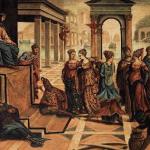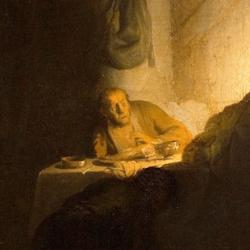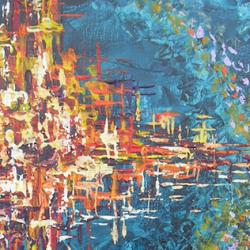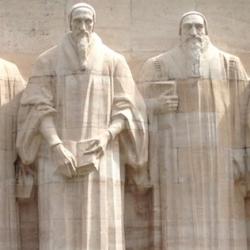Like most contemporary theologians writing on the Eucharist, David Grumett (Material Eucharist) works off of the work of Henri de Lubac. But he identifies two “principal shortcomings” in de Lubac’s eucharistic theology (8).
The first was an “excessively narrow ecclesial lens.” Eucharistic and ecclesial realism support each other, de Lubac argued, but he failed to see that “the Eucharist cannot be the Church’s sole possession. Employing the created, material elements of bread and wine, it also needs to be related through these to the life of the secular material world” (8).
For Grumett, this means that we the Eucharist has to be set “within the doctrine of creation,” and this in turn demands that we pay close attention to the “individual elements that compose the bread and wine – grain, salt, oil, water, leaven, and grapes – each contribute, both naturally and theologically, to the finished products” (8).
The second shortcoming, Grumett says, is de Lubac’s “ambivalence about materiality.” Attempting to overcome individualistic, sentimental devotion to the elements as “fetishized objects of faith,” de Lubac “contends that Christ’s eucharistic body is mystical in contrast with his historical body born of Mary, rather than in contrast with all other material bodies that presently exist. in patristic exposition, the reason for describing the eucharistic body as ‘mystical’ was, he argued, to distinguish it from Christ’s historical body – not, as might be presumed, to depict a reified divine presence. In other words, eucharistic matter is more like other matter, not less like it, than might be supposed. The recognition of this fact opens the exciting possibility of viewing Christ’s eucharistic body in continuity with other material bodies in the world” (8).
De Lubac doesn’t take the opportunity: “in embracing the notion that the Eucharist makes the Church, de Lubac only took seriously Christ’s bodily presence in its church context, in which it could be seen to generate the church community. He did not consider at any length the possibility that the Eucharist might be productive of other kings of being or life beyond the Eucharistic sphere” (8).
This runs contrary, Grumett contends, to de Lubac’s own theology of nature and grace, “according to which no part of nature may exist without the continuing action of divine grace.” There is, in short, an “unparticipated material remainder,” a residual hint of what de Lubac everywhere rejects – the idea of pure nature.
There’s a Christological oversight here: “In most of de Lubac’s oeuvre, ‘nature’ implies human nature, and he omits any serious consideration of the role of Christ in constituting, preserving, or redeeming the wider created order. De Lubac himself acknowledged this omission, stating in his introduction to Catholicism that he is excluding the ‘rich resources of Scripture and the great doctors on the subject of human solidarity with the universe.’ At no subsequent point did he make good this omission or justify it” (9).
Some of this critique sticks, though its force is weakened somewhat by the the fact that de Lubac admits the limitation and doesn’t reject a cosmic Christology.
Some of the critique, though, doesn’t quite stick. Or, if it sticks to de Lubac, it need not stick to those who make use of his eucharistic ecclesiology. A “excessively narrow ecclesial lens” is, after all, a problem only if the church is seen as one social/historical/cosmic reality among others.
If, by contrast, the church is the eschatological community, the anticipation of the human race of the end, a foretaste not only of the final order of humanity but the final order of all things, then it’s hard to see how one could focus too much on the church.
To complain about excessive focus on the church would be like complaining about excessive focus on everything. Everything is visible through the ecclesial lens. Perhaps de Lubac didn’t make that sufficiently clear, but his Eucharistic theology doesn’t prohibit such a development and, in fact, encourages it.
A similar point from another angle: Grumett complains that de Lubac’s eucharistic theology “privileges community above materiality” (6). Perhaps de Lubac pays insufficient attention to the materiality of church and Eucharist, and that is an error indeed.
But it’s an error because one cannot speak felicitously of privilege going either way. What kind of community isn’t a communio in material things? What sort of material things are we talking about that aren’t integrated into a pattern of communal life? It won’t do to flip the privilege, placing materiality ahead of community.















